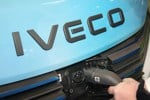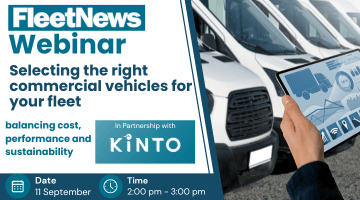Fleet management software has transformed the lives of Britain’s van fleet operators over the past 10 years. It has not only helped them run their vehicles more efficiently but has also dramatically cut down the number of hours spent poring over documents and number-crunching on calculators.
But amazing as it may sound, there are still some 14,000 fleets in the UK which do not use computers to help with their operations.
Mainly smaller concerns, these operators stick their heads in the sand, disappear under mounds of paper and inevitably run their vehicles in a most unsatisfactory manner.
We call them the ‘fag packet fleets’ as that is where you are likely to find most of their crucial information – on the back of an empty Benson and Hedges carton. The fact that there are so many potential new customers out there should be music to the ears of people like Jason Francis, managing director of fleet management software specialist cfc solutions. But Francis faces a major hurdle in reaching the fag-packeters – and that hurdle is apathy.
The fag-packeters have been running their fleets this way for years. Why should they remove their heads from the desert floor, learn new ways and put themselves through what they consider a load of trouble for nothing?
In a bid to show those people how wrong they are, we decided to indulge in a spot of role playing, in which I adopt the guise of Arthur Awkward, facilities manager at Luddite Brothers Couriers of Enfield, who must rate as one of the most appalling fleet chiefs ever to walk the face of the earth, although I’m sure many readers will recognise some of his little peccadilloes.
Francis, on the other hand, plays himself and attempts to sell me a cfc solutions package to make my life easier. Both of us are prepared and relish the challenge.
Awkward has a computer but it is only Windows 95 compatible and doesn’t have a CD Rom. He uses it mainly for playing Space Invaders. He runs 20 vehicles, which consist of four new LDV Pilots on contract hire, five one-year-old Mercedes-Benz Sprinters and five one year old Citroen Berlingos – both outright purchased – and one five-year-old Ford Transit that has been converted to run on LPG so he avoids the £5 per day London congestion charge when he enters the big city. The remainder of the fleet is a gaggle of various cars.
He doesn’t use fuel cards and his drivers simply claim the cash back when they hand in a receipt. Awkward suspects some are stocking up on sweets and fags at the same time but – hardly surprisingly – he can’t prove it.
Apart from the official papers for the vehicles, most of the relevant information is contained within the confines of his throbbing head.
He has been almost forced into calling on Francis for help after a series of fines have landed on his desk – two for allowing vehicles to be driven on a public road with no road fund licence (oops, I must have forgotten to ask my secretary Doreen to renew them) and three for operating vehicles with bald tyres (I ask my drivers to keep a check on them but they never do). If there ever was a fleet in need of help, it is that of Luddite Brothers.
The night before our meeting, I was mulling over how the interview might go. Within two minutes of shaking hands with Francis, I realised that many of my preconceptions were about to be shot to pieces.
What I had thought were a series of major challenges and traps set for him to fall into turned out to be no more than half a hiccup for his software, which is called Fleet Outlook.
And whereas I had pictured myself drilling him with awkward questions, occasionally stabbing an accusing finger in his direction while he stumbled for acceptable answers, Francis had soon turned the tables on me with his own agenda and set of solutions. My first surprise came even before we started looking at the software. I had raided the old computer cupboard at Fleet Towers to find the oldest, scabbiest computer available.
It had no CD-Rom, no internet access and ran on the outdated Windows 95 system.
‘No problem,’ said Francis. ‘Fleet Outlook can be installed via a 3.5in floppy disk and will run on Windows 95.’
Curses – foiled!
We did, however, agree that as Arthur Awkward was about to take his first stumbling steps towards the wonderful world of fleet efficiency, a new machine might be the order of the day and Francis was happy to give some good advice about what hardware to buy and where to get it.
Some of the bigger computer retailers have special business centres nowadays and they are a good place to start. The experts will be happy to fix you up with the right system and it shouldn’t even cost too much.
Minimum requirements are a Pentium lll 500MHz processor, 128 megbytes of RAM (that’s memory to you and me), a CD-Rom, email and Microsoft Outlook.
It was when we got on to the fleet management techniques employed by Arthur Awkward that the sheer awfulness of the operation finally emerged.
Tax and MoT? Well, I just remember when they are due and get Doreen to buy the tax discs or book the vehicles in to the garage for their annual ticket. It doesn’t always work very well.
Francis: ‘You realise that if your vehicles are not MoT’d then they aren’t insured either?’
Awkward (embarrassed): ‘Errr, yes, I suppose so guv’nor.’
Insurance? Ah now, we are OK there. The insurance company man just pops round once a year when it is due for renewal and I cough up.
Francis: ‘And have you registered your vehicles on the MID database last January as you were required to do so by law?’
Awkward: ‘Oh yes, I did get a letter about it but I didn’t understand it so I threw it in the bin.’
Francis (holding head in hands): ‘Tut, tut, tut.’
The list went on. Tyres, servicing, licence checking and speeding fines all got the same treatment, along with the important issue of health and safety at work. Predictably, Arthur Awkward hadn’t given it a second thought.
Summing up after his grilling, Francis told me: ‘You have a duty to think about the way you run your fleet, whether you use a computer or not. You have no checks in place, no safeguards and no proper system. All I can say is that you are heading for a big fine – and God help you if one of your drivers kills someone.
Gulp.
Now having been convinced that Luddite Brothers needs to drag itself into the 21st century and at least buy a new computer, Francis turned to the software itself.
Here I have a great deal of empathy with Arthur Awkward. I am not a computer fan and I don’t find it easy to understand all the jargon or use the various programs. But a simple demonstration lasting about 15 minutes convinced me that any van operator who didn’t want to use Fleet Outlook must be a complete masochist. Francis estimated that Arthur Awkward would need to take no more than 20 minutes a day in running his fleet. Heaven or what?
Fleet Outlook comes in four different formats and all come with a free support helpline which is open 8.30am to 6pm, Monday to Friday. For sub-10 vehicles, the software is free, up to 50 vehicles is £349, up to 150 vehicles £695 and up to 250 vehicles £995 (all prices ex-VAT). The top package comes with a day’s free training.
For fleets with more than 250 vehicles a tailored packaged called Fleet Plus is the order of the day.
The program is designed to be compatible with the email program Microsoft Outlook (that is why it is called Fleet Outlook). All Arthur Awkward has to do is spend a day keying in all the relevant information about his vehicles. After that, reports can be updated by drivers from home if they have a PC with internet access and here Arthur Awkward has a lucky break – all his drivers have such facilities. This will save him a shedload of work. By clicking on a series of ticks, the fleet manager can restrict which areas of the program drivers can gain access to. For example, they can be allowed to file accident reports only or they could submit expenses forms, change of address and maintenance reports too.
When vehicle MoT tests are due, the program can be set so the computer warns the fleet manager in advance and adds it to the ‘Tasks for Today’ section.
Tax discs are dealt with in a similar way and with servicing and repairs, parameters can be set with the garage so that repairs up to a certain amount of money are allowed without checking.
On the question of fuel, Francis recommended fuel cards as a method of cutting out fraud and pointed out that Fleet Outlook was built to be compatible with all the main fuel card suppliers.
But the main joy of the system for me was its simplicity.
Anyone with even a basic knowledge of computers could soon learn to use it.
So does Francis predict an early end to the scourge of the fag-packeters?
He said: ‘I think things will gradually get better. The new emphasis on health and safety is likely to set the balling rolling. Wait until a few companies are given big fines and we will see movement very quickly.’
Top tips for choosing a fleet software supplier
1. Look closely at the ‘people’ credentials
Try to judge their level of experience, attitude and approach. Is quality endemic in the organisation? Gauge how committed they are to providing excellent service, not just before the sale but continually. Is there a culture of excellent service? How will the supplier react if things go wrong? The difference between suppliers becomes obvious when hiccups occur, which they are bound to do from time to time. 2. Do they specialise in the fleet industry?
What is their core business? Do they have the necessary skills to take advantage of emerging technology and develop tomorrow’s systems? Do they possess the vision to push system boundaries, finding innovative new ways to manage costs and reduce overheads? 3. Does the software functionality match your requirements?
Fleet software can be complex. However, a good fleet system should be easy to operate. The complexity is dealt with during implementation, i.e. automating routine tasks. Also, a modular system will only provide the functionality required at that point in time, the benefit being that you don’t end up buying what you don’t need. This also has the added benefit that the system can grow if the requirements change in the future. Also important is the ability to tailor the system to individual users’ requirements, such as screen displays matching a user’s job role so that they only see information relevant to them. 4. Does the supplier offer a range of implementation services?
Most systems are second or third generation purchases so a data conversion from an existing system could be essential. Depending upon the size and scale of the implementation, project management and consultancy services may be necessary to ensure a timely and successful implementation. 5. How good is their training?
Ask to see training documentation as this will provide a good insight to the depth and quality of the training. 6. How good is the supplier’s software maintenance and support service?
Do they offer unlimited usage advice and technical support? 7. Commitment to keeping systems up-to-date
It is important that the supplier has a commitment to keep the software up-to-date with legislative changes and frequent service packs without additional costs. 8. Does the software product come with manuals and online help?
Most software suppliers are able to develop software but then fail to write good manuals. 9. Is there additional online web-based assistance such as FAQs, logging and tracking support queries and online ordering? 10. Is the software value for money?
Try to judge their level of experience, attitude and approach. Is quality endemic in the organisation? Gauge how committed they are to providing excellent service, not just before the sale but continually. Is there a culture of excellent service? How will the supplier react if things go wrong? The difference between suppliers becomes obvious when hiccups occur, which they are bound to do from time to time. 2. Do they specialise in the fleet industry?
What is their core business? Do they have the necessary skills to take advantage of emerging technology and develop tomorrow’s systems? Do they possess the vision to push system boundaries, finding innovative new ways to manage costs and reduce overheads? 3. Does the software functionality match your requirements?
Fleet software can be complex. However, a good fleet system should be easy to operate. The complexity is dealt with during implementation, i.e. automating routine tasks. Also, a modular system will only provide the functionality required at that point in time, the benefit being that you don’t end up buying what you don’t need. This also has the added benefit that the system can grow if the requirements change in the future. Also important is the ability to tailor the system to individual users’ requirements, such as screen displays matching a user’s job role so that they only see information relevant to them. 4. Does the supplier offer a range of implementation services?
Most systems are second or third generation purchases so a data conversion from an existing system could be essential. Depending upon the size and scale of the implementation, project management and consultancy services may be necessary to ensure a timely and successful implementation. 5. How good is their training?
Ask to see training documentation as this will provide a good insight to the depth and quality of the training. 6. How good is the supplier’s software maintenance and support service?
Do they offer unlimited usage advice and technical support? 7. Commitment to keeping systems up-to-date
It is important that the supplier has a commitment to keep the software up-to-date with legislative changes and frequent service packs without additional costs. 8. Does the software product come with manuals and online help?
Most software suppliers are able to develop software but then fail to write good manuals. 9. Is there additional online web-based assistance such as FAQs, logging and tracking support queries and online ordering? 10. Is the software value for money?













Login to comment
Comments
No comments have been made yet.